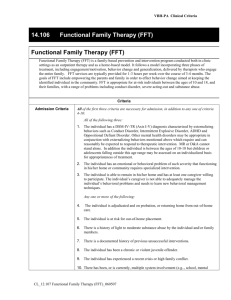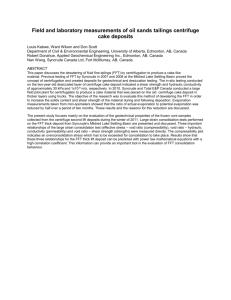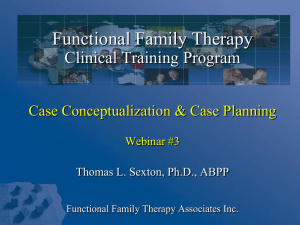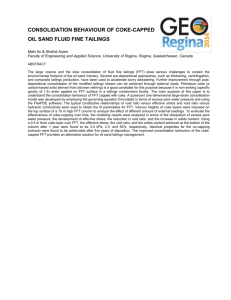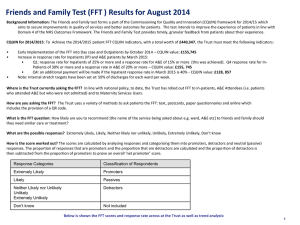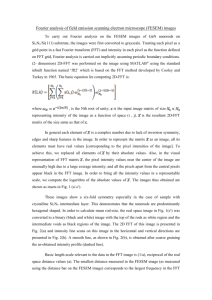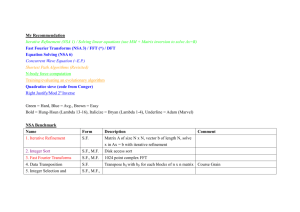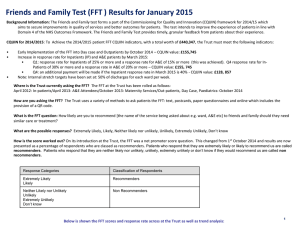Functional Family Therapy Brief Manual
advertisement
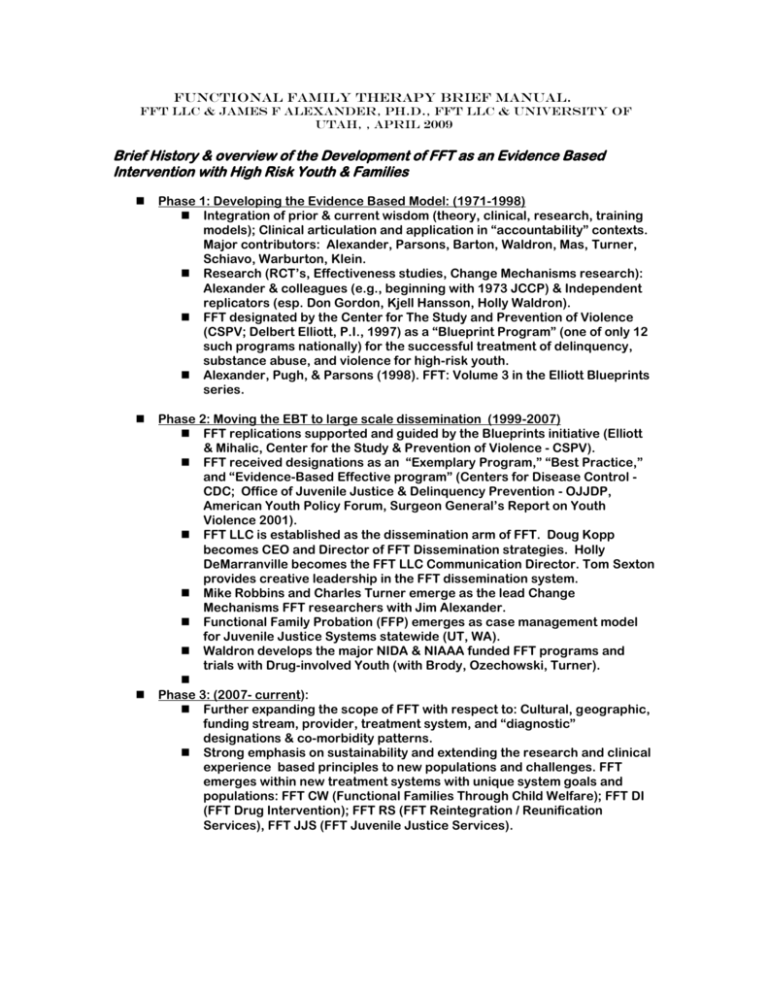
Functional Family Therapy Brief Manual. FFT LLC & James F Alexander, Ph.D., FFT LLC & University of Utah, , April 2009 Brief History & overview of the Development of FFT as an Evidence Based Intervention with High Risk Youth & Families Phase 1: Developing the Evidence Based Model: (1971-1998) Integration of prior & current wisdom (theory, clinical, research, training models); Clinical articulation and application in “accountability” contexts. Major contributors: Alexander, Parsons, Barton, Waldron, Mas, Turner, Schiavo, Warburton, Klein. Research (RCT’s, Effectiveness studies, Change Mechanisms research): Alexander & colleagues (e.g., beginning with 1973 JCCP) & Independent replicators (esp. Don Gordon, Kjell Hansson, Holly Waldron). FFT designated by the Center for The Study and Prevention of Violence (CSPV; Delbert Elliott, P.I., 1997) as a “Blueprint Program” (one of only 12 such programs nationally) for the successful treatment of delinquency, substance abuse, and violence for high-risk youth. Alexander, Pugh, & Parsons (1998). FFT: Volume 3 in the Elliott Blueprints series. Phase 2: Moving the EBT to large scale dissemination (1999-2007) FFT replications supported and guided by the Blueprints initiative (Elliott & Mihalic, Center for the Study & Prevention of Violence - CSPV). FFT received designations as an “Exemplary Program,” “Best Practice,” and “Evidence-Based Effective program” (Centers for Disease Control CDC; Office of Juvenile Justice & Delinquency Prevention - OJJDP, American Youth Policy Forum, Surgeon General’s Report on Youth Violence 2001). FFT LLC is established as the dissemination arm of FFT. Doug Kopp becomes CEO and Director of FFT Dissemination strategies. Holly DeMarranville becomes the FFT LLC Communication Director. Tom Sexton provides creative leadership in the FFT dissemination system. Mike Robbins and Charles Turner emerge as the lead Change Mechanisms FFT researchers with Jim Alexander. Functional Family Probation (FFP) emerges as case management model for Juvenile Justice Systems statewide (UT, WA). Waldron develops the major NIDA & NIAAA funded FFT programs and trials with Drug-involved Youth (with Brody, Ozechowski, Turner). Phase 3: (2007- current): Further expanding the scope of FFT with respect to: Cultural, geographic, funding stream, provider, treatment system, and “diagnostic” designations & co-morbidity patterns. Strong emphasis on sustainability and extending the research and clinical experience based principles to new populations and challenges. FFT emerges within new treatment systems with unique system goals and populations: FFT CW (Functional Families Through Child Welfare); FFT DI (FFT Drug Intervention); FFT RS (FFT Reintegration / Reunification Services), FFT JJS (FFT Juvenile Justice Services). Major Components of FFT Direct Treatment James F. Alexander Ph.D, FFT LLC & University of Utah (This phasic model and primary components based on Alexander, Barton, Waldron, & Mas, 1985; Alexander & Parsons, 1982; Alexander, Pugh & Parsons, 1998; and described in Alexander, Oct 2007) The intervention program itself consists of five major components in addition to pretreatment activities: Engagement in change; Motivation to change; Relational / Interpersonal Assessment and change planning; Behavior Change (including more precise behavioral Assessment; and Multisystemic Generalization across behavioral domains and multiple systems. Engagement In Change Motivation To Change Assessment (Interpersonal and Behavioral) Behavior Change Generalization Multi-Systems Linking PRETREATMENT GOAL ACTIVITIES *Responsive and timely referrals, positive “mindset” of referring sources. *Establish collaborative relationship with referring sources, be available, appraise multidimensional (e.g., medical, educational, justice, child welfare, mental health) systems already in place, review referral and other formal assessment data available, and note safety issues of concern for monitoring, anticipate & learn about possible cultural and additional factors. GOAL *Enhance perception of responsiveness and credibility, demonstrate desire to listen, help, respect, establish cultural competence, have proximal services or adequate transportation, contact as many family members as possible, “matching” and respectful attitude. ENGAGEMENT PHASE MOTIVATION PHASE GOAL SKILLS REQUIRED FOCUS ACTIVITIES *Create positive motivational context, minimize hopelessness and low self efficacy, change meaning of family relationships to emphasize possible hopeful experience, create positive change expectations. *Relationship & interpersonal skills, nonjudgmental attitude and demeanor, acceptance and sensitivity to diversity in all domains. *Relationship process, separate blaming from responsibility, strength based. *Change Focus techniques (Divert and Interrupt highly negative interaction patterns and blaming, Sequencing, Pointing Process, Strength based relational focus), Change Meaning techniques (Relabel, Reframe, Theme hints, Relational Themes (Behavioral and Relationship focused), monitor safety issues if necessary RELATIONAL ASSESSMENT GOAL SKILLS REQUIRED FOCUS ACTIVITIES *Elicit and analyze information pertaining to relational patterns for Behavior Change & Generalization *Perceptiveness, understanding relational processes & functions of behavior, understanding (and valuing) relational process *Intrafamily & extrafamily context and capacities (e.g., values, attributions, Relational Functions, interaction patterns, sources of resistance, resources, and limitations) *Observation, inference re the functions of negative behaviors, switch from an individual problem focus to a relational perspective Summary of the FFT Model “Attitude” during these early phases - A Philosophy / Belief System about people which includes a core attitude of respectfulness (of individual differences, culture, ethnicity, family forms, etc). - A family focused intervention involving alliance and involvement with all family members (Balanced Alliance) with therapists who do not “take sides” and who avoid being judgmental. - A phase based change model that is focused on risk and (especially) protective factors – “Strength Based” - With interventions that are specific & individualized for the unique challenges, diverse qualities, and strengths (cultural, personal, experiential, family forms) of all families and family members. - And an overriding Relational (versus individual problem) INITIAL focus. BEHAVIOR CHANGE PHASE GOAL SKILLS REQUIRED FOCUS ACTIVITIES *Additional behavioral assessment, skill building, change habitual problematic interactions and other coping patterns, enhance parent and child well being and relational processes. *Structuring, teaching, organization, understanding behavioral assessment and a wide range of potential change techniques which can be matched to each particular family and family member. *Problem Sequences & Communication patterns, cognitions relevant to dysfunctional behavior, use of technical aids & assigned tasks, assessing and improving deficits in conflict resolution & problem solving, parenting skills, compliance, self regulation. *Undertake and complete more thorough behavioral assessment of withinfamily problem behaviors and the interaction patterns that elicit, support, and reinforce them. Model & prompt positive behavior, provide directives & information, develop creative programs to change behavior but remain sensitive to family member abilities and interpersonal needs. Further assess intra-individual & physiological / biological limitations. GENERALIZATION PHASE GOAL *Extend and expand positive family and individual behavioral (including emotional, cognitive, possibly spiritual if appropriate) functioning; relapse prevention; incorporate positive community systems. Add pharmacological interventions as necessary (if they are not already in place). SKILLS REQUIRED *Multisystemic / systems understanding and ability to establish links, outreach. FOCUS *Relationships between family members and multiple community, educational, support, legal, and medical systems. ACTIVITIES *Complete more thorough behavioral assessment of outside-the-family problem behaviors (and emotional responses & cognitions) and the interaction patterns that elicit, support, and even reinforce them. Know the community, develop and maintain contacts, initiate clinical linkages, always link and refer with each family members’ Relational Functions in mind, undertake relapse prevention, help family develop appropriate levels of independence. Monitor safety issues if necessary. ______________________________________________________________________________________ The Sequence of Functional Family Therapy (FFT) Intervention From: Alexander. J.F. (2009) Functional Family Therapy Clinical Training Manual. Functional Family Therapy (FFT LLC / FFT INC) Seattle, WA Session 1 (Engagement, and Intake & Assessment if appropriate) Further develop relationship with all family members that began during phone contacts, initiate intake & assessment (if done by the FFT therapist). Otherwise, session 1 consists of establishing the relationship with the family. Initiate Motivation (therapy) Phase by using Change Focus and Change Meaning techniques, and … Begin assessment of Relational Functions and observation of family interaction patterns. End Session with assessment protocol & intake documentation, schedule next session within 2-4 days if necessary due to high risk factors. Between Sessions 1 and 2 Review family members’ behaviors, feelings, & beliefs Consider and “do your homework” about additional possible cultural match issues. Identify unclear relationships within family and with extended family or other caregivers. Identify resistance patterns of family members/caregivers. Hypothesize Relational Functions for each family member. Plan specific strategies to complete relational assessment. Plan specific therapeutic interventions (e.g., strength based themes) based on the above. Have additional conversations with all systems involved with the family i.e.: child welfare worker, school officials/teachers, probation officers, and other treatment providers to develop relationships and understanding of their perspective and expectations of case. Sessions 2 & 3 Repeat techniques of Session 1 to continue to match and build relationships with family members. Continue to use Change Focus and Change Meaning interventions. Continue relational assessment. Hopefully complete Motivation Phase goals. Reschedule next session as needed; with high risk families usually within 3-4 days. Between Session 3 & 4 Assess progress towards completing E & M Phase goals Develop intermediate and long term change goals that will that will address family relational pattern deficits, e.g., problem solving, communication, parenting skills, parent & youth well-being including such specific issues such as PTSD & substance abuse. Review and develop specific behavior change & educational techniques that lead to intermediate and long term goals as new avenues to enhance all family members’ Relational Functions . Middle (Behavior Change & Early Generalization) Sessions Apply Behavior Change technology consistent with Relational Functions of the family members. Resistance is feedback that one or more family member’s functions have not been met or Behaviro Change strategies were not well-matched to family members Develop increased family initiative in behavior change and continue to match relational functions. Prompt, look for, and support appropriate family member competence Later Phases Differentiate subsystems and specific individual issues (e.g., vocational deficits). Relapse prevention work. Generalize specific behavior changes to other family situations. Facilitate independence that is consistent with relational functions of all family members. Maintain & create new links with extra-familial systems to generalize positive intra-family changes. Evaluate quality of life issues and plan for future. Termination Problem cessation: verbal report and observed. Spontaneous family process: new interaction styles and attributions for all family members. Primary risk factors, including safety issues, reduced or eliminated; protective factors enhanced. FUNCTIONAL FAMILY THERAPY A Phase Based and Multi-Component Approach to Change FFT is about youth and families who are in trouble; however FFT also is about therapists, about treatment and other (educational, judicial, religious, cultural, political, economic, marketing) systems, about critical research and evaluation and accountability, and about values and goals. We hope to address these issues order to help readers understand what FFT is all about and how to match the unique and special qualities each youth, family, culture, treatment system, and research project brings to us. Like essentially all coherent models of change, FFT is phasic and developmental. Every system, ranging from human beings (and all animal life) to all created products (cars, symphonies, clay figures, and so on), begin in quite a different form than they later become. They go through phases which build upon each other and usually follow a specific pattern. So too do families and therapists as they undertake and compete their journey together to positive family change. Clinical Model Overview: The Phases of FFT Within Treatment and Community Systems The Big Picture: Integrating FFT with Other Systems Pretreatment System Integration Phase Assessment FFT Direct Treatment Phases Assessment * Posttreatment System Integration Phase Assessment - Engagement Referral, Preparation, Pretreatment Linking w/ Youth Mgt Systems - Motivation - Relational > Behavioral Assessment - Behavior Change - Generalization / Ecosystemic Integration Boosters, Maintenance of links w/ Youth Mgt Systems, Positive close The Youth / Family Management System(s): System(s): Juvenile Justice, Drug Court, Welfare, Mental Health: (PO’ PO’s, Case Managers, Trackers, Contingency Managers) * Based on Alexander et al, 1983; Barton et al, 1985; Waldron et al, 2001 Major Components of FFT The intervention program itself consists of five major components in addition to pretreatment and post-treatment activities: Engagement in change; Motivation to change; Relational / Interpersonal Assessment and change planning; Behavior change; and Generalization across behavioral domains and multiple systems (Alexander et. al., 1983; Alexander et. al., 1998; Barton et. al., 1985). Pretreatment Preparation Prior to actually seeing or even contacting the family, therapists engage in linking, studying, and preparing. The therapist, upon receipt of a referral, first contacts the referral source(s) quickly to acknowledge the referral and to solicit all information (including impressionistic as well as formal assessments) available. In the case of formal legal involvement (e.g., Juvenile Justice System) the therapist also clarifies system expectations and requirements, as well as issues of confidentiality. In situations where the therapist might not have experience with the culture or other characteristics of the referral, s/he will contact additional resources within or outside of the treatment system to become better informed. FFT Direct Treatment Phases Analysis of Intervention Model* Based on the “AIM Model” (Alexander, Barton, Waldron & Mas, 1983; Alexander, Pugh & Parsons, 1998) BEHAVIOR CHANGE ENGAGEMENT Assessment Assessment Assessment GENERALIZATION, Multi / Eco-systemic Linking MOTIVATION PreTreatment 1 2 3 Sessions 5 6 7 >>>> End PostTreatment The First Phase: Engagement The Engagement Phase actually begins prior to first contact, and very quickly blends into the Motivation Phase. Engagement refers to any activity that can facilitate the family’s willingness to show up for early sessions (or allow an interventionist into their home). Engagement also involves creating an initial positive reaction to the therapist. These activities can include “superficial” but important activities such as wearing clothes that seem appropriate for family members and providing therapists that would appear to be credible (e.g., gender and ethnic “matches” where this is relevant and possible). If a desired “match” is not available, therapists must be as culturally competent and work to help family members feel comfortable and respected. FFT therapists also make their own initial appointments via telephone so therapists can listen for potential problems such as transportation problems, distrust of and resistance to treatment, and confusion about thereferral and/or treatment goals. Thus, the Engagement Phase is less characterized by a formal set of therapeutic techniques than it is of an attitude on the part of FFT therapists that families should be shown as much respect as possible and be made to feel as comfortable as possible during the initiation of the process of intervention. Pre-intervention Information and Assessment. Referral information is generally already available for youth and families. Sometimes this information consists only of a name and a reason for referral (e.g., runaway, found in possession of drugs at school; parent called expressing concern that youth is becoming uncommunicative; social services receives referral regarding possible neglect. At the other extreme are cases involving youth with extensive diagnostic test information and perhaps even behavioral records in institutions, and families with a history of many social service contacts. FFT interventionists review such information, along with as much demographic information as is available, in order to understand as much as possible about the context in which intervention is to occur: Is there information available that might facilitate cultural sensitivity, be informative about multisystem pressures (e.g., poverty) and resources, and that might suggest individual constraints (e.g., learning disability, illiteracy) that must be considered? The Second Phase – Motivation: Establishing a Strong Basis for Sustainable Change Through Change Focus and Change Meaning Techniques The Engagement phase consists primarily of transitory activities that are designed to get the process of intervention “off on the right foot.” Then as direct contact is initiated in the first session FFT therapists quickly move to more powerful motivational interventions. The primary objective of the Motivation Phase of intervention is to create a motivational context within which change can occur; the family members are helped to experience a reduction in change-interfering negativity (anger, blaming, and hopelessness), coupled with an increase in change-enhancing hopefulness. Decreasing negativity is essential in this early phase of intervention, prior to initiating formal behavior change techniques, because family members’ intense negative emotions preclude them from making a realistic commitment to change. Often family members have developed rigid defensive schema through which all information is filtered, and their interactions are characterized by cycles of coercive and defensive interchanges that reinforce their automatic negative processing patterns. FFT addresses the early session (E&M) risk (for dropout) factors by engaging in two major domains of activity: Changing Focus and Changing Meaning. Change Focus techniques include: Interrupt & Divert; Point Process; Sequence, Selectively attend to positive elements of patterns and reports – and always retain a strength based relational focus. Change Meaning techniques include: Relabeling, Reframing, Creating Themes, and offering Theme Hints. Change Focus Techniques Pointing Process. A major technique used by FFT therapists is pointing process. As FFT therapists observe and attend to each family members’ perception of within-family and extrafamily interactions, they can comment on the process of how family members relate to each other. This is especially important with respect to those interactions that are characterized by negativity and blaming but are identified in a non-blaming (and if possible strength based manner). Divert & Interrupt. Simply disrupting family members’ negative interactional sequences through divert/interrupt represents a second major interpersonal maneuver which helps families de-escalate their toxic negativity. Therapists divert family negativity when they intercept a negative speech act made by a family member instead of allowing the family member to whom it was directed to answer. Therapists interrupt family negativity when they do not allow a family member who is making a negative or defensive speech act to complete a blaming diatribe. Sequencing. Sequencing behavior is a method used to assess what happens and who does what within a family. Sequencing or circular questioning is usually done around the specifics of a presenting problem. Because it is drawn out in a circular fashion it is visually easier to see the context in which behavior occurs. This information is rich in knowledge about all the participants, the action each took, and the meaning of each participant’s behavior. When a sequence is completed to include what occurs before, during, and after an event, there is often an identifiable outcome that can be tied to a theme or function of the participants (see Reframes and Themes below). When used in a relationally focused and non-blaming way, the focus of sequencing is not on the presenting or other problems but on a family interactions. This can help create an atmosphere in which family members can see their own patterns when sequencing is accompanied with nonblaming, contextual narrative. Another variation is to sequence a positive behavioral outcome so that family members can begin to see what they do “through different eyes.” Strength-based relational statements represent statements of positivity or even nobility about one person’s efforts towards another person. This also includes seeing the positive side of apparently negative relational patterns: For example (to parent and child who are beginning to argue loudly with each other): “OK – I’m going to jump in here for a second. You both are angry right now, and pretty much yelling. I’m sure that at times you or someone else wants you to stop yelling. But for now, I want to note that you seem to be at least on the same page … no one seems to be holding back much, and both of you are honest in expressing your anger. Lots of families tend to go underground with their anger … but with you two I can trust that you will bring it out and deal with it directly. That gives me something to work with that often I don’t have. Now, I wonder ….” Change Meaning Techniques Relabeling. Relabels are close to being synonyms for a behavior, but are used to switch some of the negative intensity in the meaning of that behavior. Consider a teenage son’s complaint about his mother arising in an early (Engagement & Motivation Phase) session: “As soon as I walked in the door she just went off on me!” and the therapist’s response of: “So she let you know right off the bat that she had an issue with you.” While these statements may seem quite similar, in most situations “ went off” tends to conjure up a more intense image than “ …let you know right off that she had an issue with you.” This relabel of “went off” also added a “softer” relational component (“she .. with you.”) rather than the more “attacker – victim” tone of “she … on me.” Relabels set a tone which is less intensely negative and provide the therapist more positive avenues to pursue. Reframing. Reframing is generally described as a “technique,” and although its elements may differ across therapy models, the process of reframing seems to transcend most family based intervention models. This helps us develop consistency across many agencies, therapists, and treatment populations. We also have realized that reframing is not only a technique; it also is an attitude, a perspective, and a belief system that helps FFT therapists facilitate positive change even when all of the technical elements of a reframe cannot be presented. Reframes, as we undertake them in FFT, add two components to the change meaning process: 1) Clear acknowledgment of the negative, and 2) proposal of a possible alternative (and perhaps even benign) motive. These components add significantly to the therapist’s ability to impact negativity while maintaining an overall nonblaming relationship with all family members. The most powerful, although also the most difficult to create, reframes include the acknowledgement of the negative behavior, but rather than offering an alternative neutral or benign motive for the behavior (e.g., mom’s frustration), the hypothesized motive is now more “noble” in its intent. Usually the noble intentions are seen as “misguided” but they are nonetheless well intended. Creating Themes. To generate behavioral themes, therapists identify sequences of several problem family member interactions in which all of the negative elements are identified but reframed (or at least relabeled). This focus has the advantage of helping create a family (versus individual) focus, and because all members are reframed the therapist can identify quite negative interactions and yet “come across” as seeing the possible benign intent of each member. In this way the therapist avoids taking sides and goes a long way to preventing the defensiveness that occurs when only an individual’s negative behavior is the focus. Relational themes switch the focus to relationships rather than behaviors. Relational patterns, and how they have been experienced, become the major focus. And while Relational Themes still maintain the basic elements of reframes (acknowledge negative, reframe intent or meaning in more benign if not noble terms), they often seem more like “stories” and even “myths” than specific sequences of negative behaviors. Coupled with our core generic principles of matching and respectfulness, our powerful change meaning techniques help families move quickly to being open and responsive to techniques to change behavior (in both the short and long term). Note regarding FFT “front loading:” The spacing (number of days) between the first, second, and third FFT sessions depends primarily on: 1 - the severity of risk factors, 2 - the immediate availability of protective factors, and 3 - your over all judgment of how long the family can go without a major disruption. - With high risk families we would expect 3 sessions in the first 10 days of FFT. Assessment in Early Phases (Engagement and Motivation): Relational Functions By the time FFT receives referrals for dysfunctional behavior patterns, the relational functions they express in important relationships usually are established and easy to recognize; rarely do adolescent disruptive behaviors (nor parenting “styles” and “challenges”) emerge “all of a sudden.” As a result FFT looks for stable patterns, first assessing the relational functions. These “relational functions” represent inferred internal motivations based on overtly expressed (behaviorally, verbally, emotionally, even physiologically) patterns within the family. After at first focusing on within-family interactions, FFT repeats the assessment process for relationships and problem behavior patterns outside the family (especially with peers). FFT does not attempt to change the relational function itself, but we do change the cognitive, physiological, emotional, and behavioral strategies in which the youth or parent engages to meet relational functions. If a child acts out to “get attention” FFT does not work hard to eliminate children’s need for attention! Instead we change the means though which this attention is elicited. This of course usually requires dealing with the rest of the system(s) involved with the youth Relational Connection: Contact/Closeness/ versus Distance / Autonomy/ Independence. The most salient category for FFT represents the degree of interpersonal connectivity seemingly involved when a person expresses a stable behavior pattern that directly or indirectly impacts another person (or persons). The degree of connection can range from “close” and highly interconnected to “distant” and quite independent or autonomous. These dimensional anchors do not represent fixed and invariant points on a dimension; they are instead the seeming central tendency (or apparent “default mode,” or “average “) behavioral pattern that best characterizes the ongoing relationship. Whatever the behavioral pattern is over time, FFT’s intervention philosophy the respectful acceptance of the diversity that all family members bring us in terms of what we call Relational Functions. All three of those relational states can be adaptive, and all three can be maladaptive. The problem is not what the relational function is, but how it is expressed and met. Within Family Relational Functions: Degree of Connection / Attachment As Reflected In Typical Behavioral Patterns : high 1 Autonomy: independence separating, (Fear of Enmeshment?) 2 Autonomy 3 Mid ting n i o p Contact/4 closeness 5 low low Contact: closeness, connection: enmeshment, (Fear of abandonment?) high The Second Dimension: Relational (“Relative Power”) Hierarchy. Relational Hierarchy reflects the pattern of relative influence parent & youth have over each other in terms of “controlling” each others’ behavior. With Adolescent Disruptive Behavior Disorders (DBD’s) it is common to use such phrases as “S/he’s out of (parental) control.” However, FFT examines not just the behavior patterns of one individual. Instead we examine the relative balance of control and power rather than simply isolating our focus on whether or not the parent can “control” the youth. When we broaden our focus to look at the relative balance of power, it is not at all uncommon for us to find that a youth is able to exert less or more “control” over a parent’s behavior than vice – versa. Interventions that fail to examine the relative balance of the interpersonal “control” in these relationships often fail repeatedly if all they attempt to do is to increase the “control” the parent has “over” the youth. In many ways parents experience the “power” issue as the most salient in raising adolescents, however FFT asserts that primarily what parents want is a sense of being able to control (if not help) their youth. As a result, when FFT provides alternative ways to influence youth relationally, hierarchy itself becomes less salient. In fact, many parents are quite pleased when their kids begin to “obey” because the relationship with the youth has been “repaired” and the youth now wants to maintain a positive and less blaming relational pattern with the parent(s). Power and consequences are important, but difficult to achieve in many cases, and certainly less positive than relational changes that motivate youth to comply and develop positive behaviors without the constant use of power and consequences. The Second Relational Dimension: Hierarchy Hierarchy refers to the pattern, over time, of relative influence based on power, power, position, position, and resources (as opposed to Relational Connection” Connection”) Parent 11- up Parent Symmetrical: (Exchange = Behaviors) Parent 11- down Unlike the concept of personality which presumes a core underlying motivational structure, FFT assessment of functions often identifies important differences within one person. The FFT interventionist understands for example that the motivational needs of the parent with different children can be markedly different. As a result, behaviors that would be comfortable for the parent with respect to the “close” child could be quite unacceptable with respect to the distanced child. Thus prescriptions for good parenting cannot be simply homogeneous since the behaviors through which effective parenting is carried out will differ depending on the child in question. Finally, the assessment of relational functions is essential if therapists want to insure rapid compliance with change interventions. Prescribing tasks or change strategies for one family member with respect to another member will elicit considerable resistance if the prescriptions are implicitly or explicitly inconsistent with the family members’ functions. Simply put, the more divergent the techniques are from the relational functions, the more resistance (e.g., poor participation and dropout) the therapist will face, and the more external forces need to be brought to bear to facilitate (force?) and maintain change. As an empowerment model FFT offers a more relational and less opposition based belief system and intervention philosophy. Transitioning between Engagement & Motivation into Behavior Change Over the years FFT has utilized two broad classes of “techniques” for Behavior Change. The first class is represented by general skill-building processes such as communication training, problem solving, and conflict management techniques. We use these techniques in almost all families, and they represent skill development which is useful to family members when they interact, but they also generalize nicely to other extrafamily systems (school, work, friendships). The second class of techniques represents problem specific techniques which may apply to some people and families but not others. These include “internal” coping techniques involving anger, impulse problems, and cravings; challenges unique to some families such as a single parent with physical disability which preclude many parenting strategies, or youth referred with specific developmental disorders. Special techniques or unique configurations of behavior change approaches also may be utilized, for example, when severe trauma / PTSD has been experienced by the youth (or parent, or both), and when youth spend time with two active parent figures who live separately and who may have their own new family relationships developing. Behavior Change (BC) * Develop individualized change plans that fit “match”) the family (values, Relational Functions, abilities) and which increase resources and competence in adaptive positive behaviors * Eliminate dysfunctional behaviors (drug abuse, delinquency, violence, maladaptive expectations & beliefs, etc) by changing the processes (intra-individual, family relational, multisystemic) that support them; BEHAVIOR CHANGE *Change the problem and related behavior(s) by using the therapist skills of Teaching, Modeling, Coaching, providing Technical Aids, and giving Directives & Homework that helps families improve their ability in: Parenting, Youth Compliance, Communication, Problem solving, Conflict management, Managing anxiety, “urges,” PTSD, etc. Behavior Change: Specific Elements The FFT therapists’ style shifts during Behavior Change, becoming much more structured, direct, and in some ways hierarchical than during Engagement and Motivation. In addition, FFT interventionists prescribe specific interpersonal tasks often involving the technical aids. Communication Training. Communication training is commonly used in FFT. In some families the training represents a focus on a true skill deficit; the family members truly do not know the basics of interpersonal communication. In many other families, however, family members know how to communicate quite well (e.g., some have been effective teachers, professors, clergy, girl scout leaders, etc.). However, in the current individual/family/community context they are unwilling or unable to communicate in the effective ways they can demonstrate in other contexts. With family members who truly are characterized by skill deficits, emphasis is on explaining and practicing the positive elements of communication listed below. When instead the problem is one of performance rather than ability, emphasis is placed on the reattribution (e.g., reframing) interventions described earlier, and providing constant reminders of the rationale behind positive and effective communication. Elements of Positive Communication Source Responsibility. Needs and reactions are expressed in “I” statements Source Directness. Directness if the complement of source responsibility Brevity. Communications must be short to avoid overloading and facilitate which facilitate the centering of responsibility on the speaker Keeping statements at a personal level reduces blaming and defensive communications. involving the specific identification of “you” in expressions. This helps avoid third-person comments, innuendo, and inappropriate generalizations. listening. Family members are often literally asked to state their needs or reactions in ten words or fewer. By requiring member to do this, it reduces unnecessary statements and the opportunity to blame others or make provocative accusations Concreteness and Behavioral Specificity. Abstractions such as “being Congruence. Family members are helped to present messages that are Presenting Alternatives. By presenting alternatives, family members move the Active Listening. The art of active listening as developed by Rogers and others Impact Statements. In response to someone else’s communication, impact responsible” must be translated into specific behaviors to be performed at specific times. When trust is only emerging, or still not present, an ambiguous situation provides too many opportunities for failure. Helping family members translate their feelings and demands into specifics facilitates negotiation, contracting, and presenting alternatives. congruent, or consistent, at the verbal, non-verbal, behavioral, and contextual levels. Family members are assisted by the therapist to provide congruent verbal and non-verbal cues, then helped to learn how to help each other to do this in the absence of the therapist. atmosphere away from non-negotiable demands, and helps all family members see the benefit of flexibility in their problem-solving attempts. They allow the presenter to retain a sense of control, yet also provide the recipient with a sense of having options. involves the presentation of cues, by the listener, both during and after the time someone else communicates. These cues reflect accurate listening and include eye contact, nodding, leaning forward, and restating or rephrasing what was communicated, in content as well as in the feelings expressed statements provide feedback in terms of personal reaction that require no justification from either party. Their expression helps family members break up what often seems to be wired in relationships between feelings and behavior. Examples of impact statements include: “When you do ______, the effect on me is _______”; “The impact on me when ______, is that I feel _______.” Basic Parenting Principles/Techniques. Positive reinforcement/praise, negative reinforcement, ignoring, distracting, clear limit-setting with consistent follow-through and a reasonable number of limits, parent-child special time, and parental monitoring of activities are applied when deemed appropriate during the Behavior Change Phase of FFT. On their own, parent management techniques appear to be more effective with younger rather than older adolescents. Because FFT is a systemic model and all family members are included in therapy, choosing and relaying these techniques to family members must be done in a sensitive and flexible way. In general, the use of these basic parenting principles is encouraged in FFT through incorporation into the more systemic and collaborative techniques of response-cost and contracting. Therapists should keep these principles in mind, but their application is more commonly conducted through more systemic means than classic parent-training. Contracting. Contracting involves having family members identify specific things they would like other family members to do in exchange for interactions/behaviors or tangible rewards. This procedure is especially important with adolescents (as opposed to your children). In fact, other than basic communication training, contracting is the parentyouth interaction/ influence technique that is most commonly used by FFT therapists because it is systemic (e.g., involves considering the idea of reinforcement / reward for all members of a system or subsystem). Therapists also need to monitor contracts to make certain they are attainable based on the functional relationship needs of each participant. Finally, therapists need to monitor the in-session contracting process to maintain the decreased negativity attained during the Motivation Phase. To this end, therapists often refer back to specific reframes and themes from the Motivation Phase that were particularly helpful in creating positive attributions in family members. If communication training was conducted earlier in the Behavior Change Phase, the therapist will also model and remind the family to use communication techniques during their in-session contracting discussions. Response Cost Techniques. Especially effective with children and preadolescents, the specific approach to reward and punishment identified by Webster-Stratton and Herbert as Response-Cost Techniques provide a wonderful framework that helps a parent or parents learn how to set clear penalties (typically loss of privileges/current rewards) for inappropriate child behaviors or failures to perform. Expected behaviors and penalties should be fair and clearly stated, and augmented by visual aids whenever possible Additional Intervention Strategies. In addition to providing communication and additional skill training, FFT interventionists prescribe specific activities and behaviors that will enhance the family’s experience of positive change. In particular, interventionists utilize as many technical aids as possible. These technical aids include such simple items as sticky-type notes that can be put on mirrors to remind family members about a particular behavior, audiotape recordings of communication practice session that can be taken home for review, commercially available manuals on parenting, a wide range of similar free information provided by social service agencies, training in the use of answering machines and cell phones to leave messages for family members, a schedule of reminder telephone calls made by a volunteer to families who need additional structure to change old behavior patterns, and so on Interventionists also are reminded to be very creative and energetic with respect to providing specific and concrete resources for families as they enter the change process. We don’t want to send families (many of whom have only limited resources and few good work habits) out of sessions with little more than suggestions about how to change behavior. Instead we are much more direct and in some ways “controlling” (or “educational”) during Behavior Change. Using Technical Aids (examples) tape recordings, therapist handouts for family to take home & review reminder cards / post-it notes /charts, notes, message centers on refrigerators school-home feedback systems answering machines, beepers, 2-way radios, cell phones pictures, “corny sayings,” symbols relaxation techniques Conflict Management Avoid conflict situations as much as possible Change reaction to early steps in the process Contain it… Present orientation (no “gunnysacking”) Issue focused (no “character” attacks) Time - out for transitions Problem Solving 1 Identify a problem in a specific incident/area/with a specific problem 2 Use principles of positive communication 3. Clarify desired outcomes for all participants 4. Agree / negotiate regarding what it takes to accomplish the task 5. Try to anticipate all the ways it can go wrong 6. Review plan, develop relapse prevention plan The above examples represent the more common techniques used by FFT therapists. However, just about any structured activity can represent a useful technique in FFT Behavior Change, as long as the behaviors they create and maintain are consistent with Relational Functions. Over the years FFT therapists have utilized a very wide range of cognitive-behavioral techniques, trauma and experiential techniques developed in other contexts, and already established cultural practices (preparing meals together, etc) as contexts for FFT Behavior Change. Once they become comfortable with the core construct of “matching,” FFT therapists have found almost limitless techniques available during this phase of FFT intervention. The Generalization Phase of FFT The FFT Therapist as “Family Case Manger.” Unlike generic treatment planning which sometimes wraps services around families and family members with little consideration of family dynamics, FFT focuses on each individual family’s interpersonal and systemic needs when considering adjunctive support services. In addition, before ideas with good face validity are implemented to advance a treatment plan, it is necessary for a therapeutic alliance to exist for the family to view these ideas as valid, and the idea must be based on an understanding of the functional aspect of family behavior. FFT believes that extrafamily (ecosystemic, multisystemic) links must incorporate developmental, and synergistic intervetions, and they must be consistent with each another as well as the family’s culture. FFT extends or exports family functioning into a variety of community systems, which helps the family as well as the community. It is our belief that adjunctive services often (or usually) must be developed in order for the treatment effect to generalize. In doing so, the FFT Family manager helps anchor the family and the family members to a larger supportive community. Because of this, successful intervention cannot begin with this phase of intervention. To simply wrap services around a family or family member without considering the impact on family functioning is to risk destabilizing the already precarious family process. Thus, the accomplishments of the Generalization Phase are predicted on successful handling of therapist-family core therapy processes. FFT Direct Treatment Phases Analysis of Intervention Model* Based on the “AIM Model” (Alexander, Barton, Waldron & Mas, 1983; Alexander, Pugh & Parsons, 1998) BEHAVIOR CHANGE ENGAGEMENT Assessment Assessment Assessment GENERALIZATION, Multi / Eco-systemic Linking MOTIVATION PreTreatment 1 2 3 Sessions 5 6 7 >>>> End PostTreatment Summary of the FFT Model & Core Elements In sum: FFT is a relational, family based, ecosystemic, communication theory, and cognitive-behavioral based model, with consideration of intrapsychic (or at least intraindividual) factors and biogenic influences. FFT produces change through a phase based process (Engagement, Motivation, Relational Assessment, Behavior Change, Generalization / Ecosystemic focus). These phases are wrapped in, and informed by core concepts of matching, non-blaming relational focus, balanced alliance and respectfulness with all family members involved. It should be noted that while various conceptual systems, each of whom involve specific assessment and intervention components, have informed the development of FFT, the elements are not conceptualized and treated in an eclectic or haphazard manner within FFT. Nor is any one historical perspective adopted in its entirety. FFT recognizes that each perspective, and the processes they assume to be relevant, may be more or less influential or appropriate in any given family or even any particular aspect of a family. As in Bandura’s (19xx) notion of “reciprocal determinism, some families face biological challenges that others do not; some families and family members have experienced pervasive levels of “trauma” in the past, and some have not; some families are trying to exist in very negative community contexts, others are not. As a result FFT is an “integrative” model which allows us to conceptualize families and problem behaviors, as well as family strengths, from various perspectives depending on a number of contextual variables. However, these perspectives must not be mutually exclusive nor represent paradigm shifts or clashes with respect to FFT core principles . In all this FFT is clear about the overall principles and perspective that guides the integrative process. Our “default mode” is relational and respectful, but it is accommodating enough to utilize other perspectives as long as they are consistent with the core FFT model and they help the therapist understand and intervene with this particular family, effectively, at this particular time . And finally, FFT represents a motivational and a systems model; that is, the behaviors we address clinically are assumed to be motivated “internally” on the part of the people evincing them, yet the behaviors also “co-influenced” by others in the environment. Others influence, if not determine, what individual behavioral expressions are acceptable, and they influence (if not determine) how behaviors “function” in the context of those other important people. As such FFT is both an individual and a relational model. We assess the intersection of these forces and how they emerge in terms of the Relational Functions that represent that intersection.

